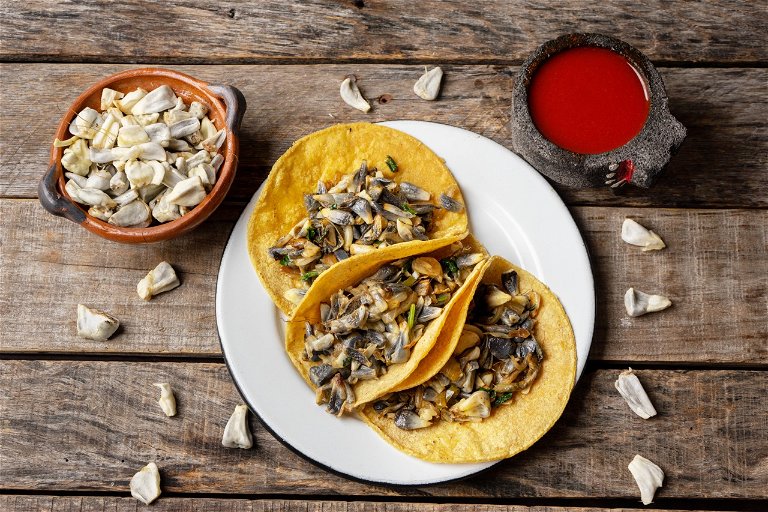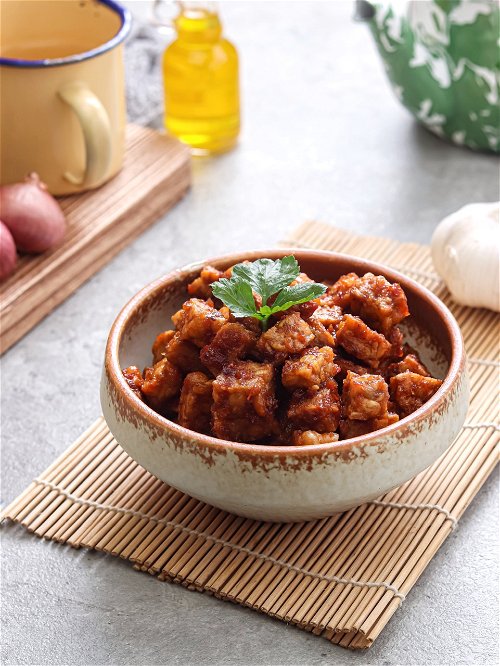Funky Funghi: on the spores of culinary moulds
From fermented soy sauce to the exotic appeal of blue cheese, tempeh and huitlacoche, moulds have infiltrated haute cuisine. Falstaff goes on a search for noble mushrooms.
Koji: The Umami Alchemist
It's time to pay tribute to the unsung maestro behind some of the most iconic dishes from the Land of the Rising Sun; Koji is the unsung hero of Japanese cuisine. This mould may not be particularly glamorous, but its influence is downright alchemical. Koji represents the magic behind miso, soy sauce, sake and countless other staples of Japanese cuisine. Koji transforms simple ingredients like soybeans and rice into umami-rich marvels through the process of fermentation. Despite its culinary prowess, Koji often ekes out a shadowy existence, overshadowed by its fermented progeny.

Huitlacoche: The Mexican corn mushroom
From the heart of Mexico comes "Huitlacoche", a mushroom treasure that, like many moulds, remains hidden. This jet-black mould, also known as corn rot or Mexican truffle, thrives on corn kernels and transforms them into a delicate speciality. Its rampant appearance may not win any beauty contests, but its depth and complexity of flavour should not be underestimated. The transformation of huitlacoche from a crop-destroying mushroom into a culinary delicacy demonstrates human ingenuity.
The ingredient remains controversial; while some are hesitant to embrace its unconventional appeal, connoisseurs know about the flavourful diversity of "refined" corn kernels as an additive in a variety of dishes. To do this, for example, simply hold the cobs with the stem side up and cut them with a sharp knife from top to bottom. Then saute the huitlacoche with spices such as onions, garlic and chilies until they are soft and darker in colour, then season the delicacy with a little salt to finish.

Tempeh: the power of soybeans
From the lush archipelago of Indonesia comes another mouldy delicacy - tempeh. This traditional soybean cake is a staple in Indonesian cuisine and a vegan protein powerhouse. It is produced in a fermentation process with the help of the mould "Rhizopus oligosporus". The mould binds the soybeans into a dense cake with a nutty flavour and a firm, satisfying texture. The versatility of tempeh makes it a star in vegetarian and vegan cuisine worldwide. For some, however, the strong, earthy flavour of tempeh takes some getting used to and can only be truly appreciated over time.
Camembert and blue cheese: kings of the noble mould
Loved and hated; no discussion of culinary moulds is complete without paying homage to Camembert and blue cheese. These mouldy masterpieces from the dark depths of cheese factories are a testament to the power of penicillium. It transforms ordinary cheese into a marbled wonder, adding bold, complex flavours. During the ripening process of blue cheese, the cheese wheels are pricked with wide needles, i.e. pricked so that oxygen can penetrate the cheese through the channels created, thus promoting and accelerating the formation of mould.
From white and black truffles
The mysterious underground mushrooms known as "black diamonds" lurk under oaks and hazelnut trees in regions like the Périgord; we are of course talking about the truffle. With their heady aroma and earthy flavour, truffles sometimes fetch astronomical prices and have graced the tables of royalty and gourmets for centuries. The fascination of truffles lies not only in their taste, but also in their hunting. Truffles just do not like to be cultivated and grow underground where they feel comfortable. Nowadays, instead of pigs, almost only truffle dogs are used to track down this delicacy - the pigs too often ate the fine tubers themselves.
A plea for perseverance
Isn't it just the same with all these mouldy delicacies like caviar and oysters? Only with time and after several attempts does one really learn to duly appreciate the locked-in flavours. After all, who gulped down his first oyster with relish without contorting his face at least a little? Perseverance helps - as so often in life.


